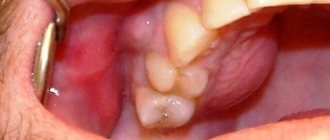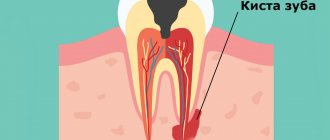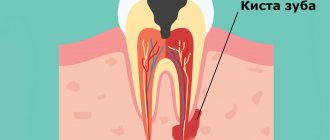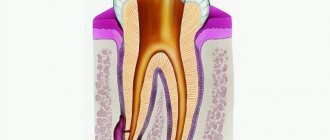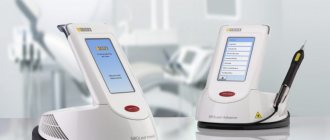When deletion is indicated
Modern dentistry strives to preserve teeth and their roots whenever possible, but this is not always possible. Dental surgeons remove teeth with cysts for the following indications:
- the infectious process was caused by an advanced form of periodontal disease;
- there is a vertically located crack on the root of the tooth or on itself;
- the dental root canals are impassable, as a result of which therapeutic treatment becomes impossible;
- severe tooth decay, and restoring it does not make sense (too expensive and time-consuming);
- the tooth is located entirely in the cavity of the neoplasm;
- the cyst has grown into the nasal cavity, or the size of the tumor is more than 10 mm;
- the root of the tooth has fused with the neoplasm;
- the tooth is very loose.
The dentist decides to remove a tooth with a cyst after a thorough examination of the patient, which includes examination, history taking, radiography or visiography.
What is an apexectomy
Stages of tooth root resection
This is a surgical procedure that allows you to get rid of the source of infection located inside the gums without removing the tooth unit. Otherwise called resection of the apex of the tooth root. Often, infectious foci form in the area of the tooth root, and apexectomy allows you to cut out and remove the affected part of the root without affecting healthy tissue. This treatment method is considered the best for granuloma, periodontitis and similar serious pathologies, in which the affected teeth were removed in the past.
Removing a tooth with a cyst: does it hurt or not?
In the “Optimal Choice” dental clinics, when removing teeth with benign formations at the roots, the latest anesthetics and modern equipment are used. Therefore, patients do not need to be afraid of anything at all. The doctor selects anesthetics on an individual basis; in some cases, general anesthesia may be recommended (we do not use it). Minor pain may occur after tooth extraction, when the anesthesia wears off. To relieve pain, your doctor may prescribe painkillers.
Types of deletion
A dental cyst can be treated using one of the following surgical methods:
- Cystectomy is the most common way to remove cysts on teeth. During this operation, an incision is made on the gum, through which both the benign neoplasm and the apex of the tooth root with pathology are removed. The cystectomy procedure is usually performed under local anesthesia, after which the doctor prescribes antibiotics to the patient.
- Hemisection - this type of removal is used if a tooth with a cyst has more than one root, and at least one of them is pathologically changed. During this procedure, the cystic formation, the root of the tooth with pathology, and part of the tooth itself are removed. After this operation, a crown is placed on the tooth.
- Cystotomy is the most gentle type of surgical treatment for dental cysts, in which the doctor removes only the front wall of the tumor. The tooth body is completely preserved.
These techniques are an alternative to the complete removal of teeth with cysts. But it is not always possible to apply them. To completely remove teeth with benign tumors, the extraction method is used. The operation can be performed urgently or planned.
Types of dental cysts
There are several types of molar cysts, which are classified according to location and depending on the reasons for their formation.
Depending on the location, the following types of cysts are divided:
- A cyst on the root of a tooth: it can be interradicular, peri-radicular and basal. With a tooth root cyst, symptoms do not appear for a long time, and only at a late stage does a purulent capsule form and pain appear.
- Cyst on the gum: with this type of dental cyst, the fistula can form in any area of the gums; filling with pus occurs a little later. A cyst near a tooth may be accompanied by a tingling sensation. As with other cases of fistula formation, the consequences of a cyst in the gum of a tooth are quite serious.
- A dental cyst in the maxillary sinus: can only be diagnosed with the help of special equipment, since otherwise it is impossible to notice even a large dental cyst in the maxillary sinus. With an advanced dental cyst, sinusitis can become a sad and very unpleasant consequence.
- Cyst under the crown of a tooth: most often this is a cyst after dental treatment that was unsuccessful. In this case, a bubble is formed when the crown is installed incorrectly - as a result of the accumulation of food and the proliferation of bacteria. It is quite difficult to detect this type of cyst at an early stage. To treat a tooth cyst with a crown, the latter will need to be removed.
- Wisdom tooth cyst: appears as a result of difficult eruption or chronic inflammation of the “eights”. The only treatment option is to remove the affected tooth.
The cyst of the front tooth should be specially noted. In general, the disease does not differ greatly from other types, however, due to the fact that the teeth in the anterior section are much narrower, this affects the volume of the surrounding soft tissues. Therefore, an upper tooth cyst (or a lower tooth cyst) in the front part of the jaw has much less room for localization, and it begins to come out only in the gum area. For comparison, a cyst on the back teeth can form a fistulous tract even through the cheek or neck.
According to the reasons for their appearance, the following types of cysts are distinguished:
- Radicular
or odontogenic dental cyst: the most common type. It is formed in the upper third of the dental root from a granuloma - as a result of pulp necrosis and periapical (at the root apex) inflammation. The diameter of a radicular dental cyst varies from 2 mm to 3 cm. If there is no secondary inflammation, the disease is asymptomatic, there is no displacement of teeth or effects on bone tissue. - Residual
: a cyst after tooth extraction, formed in a situation where the root apex was not completely removed or a granuloma formed in the area of the missing tooth. A cyst after tooth extraction has the same properties as a radicular one. - Keratocyst
, also called primary and primordial: formed due to a developmental disorder. No tooth is immune from this, but most often it is a cyst due to inflammation in the area of the premolars and third molar of the lower jaw. With its development, the likelihood of relapse is high. - Teething cyst
, or retention cyst: is formed during the period of replacement of primary dental units with permanent ones. A tooth retention cyst looks like a bluish swelling that contains blood inside. In most cases, the fistula is formed due to slow eruption and can open at any time. - Follicular
: formed in a situation where a tooth for some reason cannot erupt and grows inside the soft tissue. As a result, a cyst forms on the gum around the tooth. Such a cyst grows quickly, can move to other teeth and is fraught with extensive damage to them. With the development of a follicular dental cyst, complications can be expressed in the tilting of adjacent teeth, displacement of unerupted teeth, and root resorption. - Lateral periodontal
: the exact causes of occurrence are not fully determined. As a rule, these are small cysts associated with the lateral surface of the tooth root. - Calcifying odontogenic
: formed in the area of the supporting surface mainly of the lower jaw. The reasons for its appearance are also not fully understood.
What are the stages of the operation?
The procedure consists of the following steps:
- The desired area is numbed using conduction or infiltration anesthesia.
- The gum is peeled off from the wall using a rasp.
- The tooth is loosened and removed using forceps or an elevator.
- The dental unit is removed from the socket. In difficult cases, the tooth is first sawed into pieces using a drill, and then each of them is removed separately.
- The extracted tooth and socket are examined by a doctor.
- The cyst cavity is cleaned, and the wound is treated with antiseptic drugs.
- The wound is stitched up.
- Using an X-ray examination, the doctor makes sure that fragments, particles of the tooth and the removed tumor do not remain in the jaw.
- Antibiotics, anti-inflammatory drugs and anesthetics are prescribed.
Two to three days after the operation, you need to re-visit your dentist to monitor the condition of the tooth socket.
Conservative treatment of dental cysts
A dental cyst can be cured using conservative methods - but this is only relevant for those cases when the disease was diagnosed in the early stages and the size of the formation does not exceed 1 cm. An important condition is the patency of the root canals, since it is through them that drug treatment is carried out. It is worth noting that the conservative method is used more often in young patients.
The main goal of conservative therapy is to eliminate the inflammatory process. It is carried out in several stages:
- Gaining access to the root canals - removing tissue softened by caries or an old filling, studying the patency of the canals, their direction and length. To do this, the dentist inserts small instruments into the canals and takes an x-ray - this allows you to clearly assess the condition of the tissues. Afterwards, the canals are processed mechanically - using tools, and, if necessary, expanded.
- Medicinal treatment of the canals with antiseptic agents - rinsing with Chlorhexidine and sodium hypochlorite.
- Opening of the apical foramen and removal of antibacterial drugs beyond it, into the cyst. To neutralize the acidic environment of the cyst, highly alkaline drugs are used - usually calcium hydroxide. It helps to destroy the walls of the cyst, destroy pathogenic bacteria, protect bone tissue, and accelerate healing.
- If necessary, the application of the drug is repeated - as many times as necessary to stop the inflammatory process.
- Temporary canal filling. It is carried out after the doctor is convinced of the effectiveness of therapy and the absence of disease. The canals are filled temporarily for the purpose of further monitoring the condition of the tooth - if, according to the results of a subsequent assessment of the condition of the tissues, inflammation is not observed, the canals are filled with permanent material.
Next, it is important to visit the doctor according to the schedule, since it is necessary to assess the dynamics of bone tissue restoration.
Physiotherapy can also be added to the main course of therapy. Relatively recently, depophoresis began to be widely used - it allows you to eliminate infectious processes in the canals of the root system. This method consists of using copper-calcium hydroxide - the affected tissue is exposed to a weak electric current, which promotes deep penetration of the drug. Often three sessions are enough to completely eliminate the disease.
Possible complications
Among the common consequences of removing a tooth with a cyst may be the following complications:
- slight increase in body temperature;
- migraine;
- soft tissue swelling;
- toothache.
In order to alleviate the patient's condition, symptomatic treatment is prescribed.
If the doctor is insufficiently qualified or the patient does not comply with medical recommendations, the following complications may arise as a result of surgical intervention:
- infectious process in tissues;
- injury to nerve endings;
- profuse bleeding.
To avoid this, you must contact only trusted dentists with good experience and clinics with modern equipment, and also follow all recommendations given by your doctor.
Symptoms of a dental cyst
The formation of a dental cyst occurs slowly. The first stage is the formation of a granuloma - it is difficult to diagnose and does not cause unpleasant symptoms. There may be only slight pain in the gums and teeth during chewing; as a rule, it does not cause inconvenience.
Only X-ray diagnostics can reliably determine the presence of a developing cyst. Since there is no cause for concern, the scan is most often performed for other reasons - for example, before installing braces or a prosthetic for another tooth.
As the cyst grows, the patient begins to feel an increase in symptoms and notes the appearance of new signs:
- pain in the gums and teeth can radiate to the opposite dentition;
- body temperature rises;
- swelling of the soft tissues forms around the tooth, swelling of the cheek on the causal side.
Other symptoms may indicate complications that have already begun.
Preventive measures
To ensure tissue healing proceeds faster and serious complications do not arise, a number of recommendations must be followed. Dentists at the Optimal Choice clinic give the following advice to their patients:
- For several days after surgery, rest is required; any physical activity (even light) is contraindicated;
- avoid hot water procedures, including baths, steam baths, saunas, and do not use hot compresses;
- You cannot use active mouth rinses for 2-3 days; if necessary, they can be replaced with oral baths with infusions or decoctions of medicinal herbs (with oak bark, calendula, eucalyptus, sage), furatsilin, chlorhexidine, etc.;
- do not drink alcoholic beverages or smoke for 2-3 days;
- Taking medications prescribed by a doctor is mandatory.
Compliance with these rules, as well as regular visits to the dentist for preventive examinations and at the slightest unpleasant symptoms, will allow you to avoid serious negative consequences and significant financial expenses for dental services.
Sedation - cyst treatment in absolute comfort
Rescue for patients with dental phobia and during large-scale work that requires a long stay in an uncomfortable position
- Fears, physical and psychological discomfort are excluded
- Sedatives do not carry any burden on the body
- Easy “exit” after treatment, after 30 minutes you can go home
Experts' opinion
Question: Is it possible to avoid the occurrence of a cyst on a tooth?
Answer : The etiology of the formation of a cyst at the root of a tooth can be different. At the initial stages, treatment of this pathology does not pose a serious problem. Therefore, it is very important to be regularly examined by a dentist, and also to take x-rays or visiography at least once a year to identify any pathologies of the dental system. New growths, if present, will also be visible on the images. To reduce the likelihood of tumors appearing, if any diseases of the oral cavity and nasopharynx occur, it is necessary to treat them in a timely manner: develop the habit of regularly rinsing your mouth with antiseptics, and learn to brush your teeth correctly. Maintaining a healthy lifestyle, a balanced diet, a strong immune system and preventive dental examinations are the key to dental health.
Question: Is it possible to get rid of a cyst on a tooth at home on your own?
Answer : We do not recommend self-medication if you have any pain or unpleasant symptoms in the oral cavity. Any discomfort may be a sign of a serious illness that requires medical attention. If it is not possible to urgently visit the dentist, then to reduce pain you can use the following rinses: herbal decoctions (yarrow, calendula, sage, chamomile, oak bark), a solution of baking soda or salt, vodka, tea tree essential oil. This may help reduce pain, but in any case you should see a doctor as soon as possible.

